September 20, 2019
Air Date: September 20, 2019
FULL SHOW
SEGMENTS
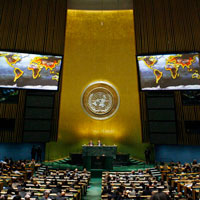
UN Climate Action Summit
View the page for this story
Sept 23rd is the 2019 United Nations’ Climate Action Summit, an opportunity for nations to ramp up their greenhouse gas reduction commitments under the Paris Agreement. And Climate Week NYC, scheduled from September 23rd to September 30th, aims for sub-national governments, businesses, activists, and more from around the world to come together and discuss climate action. Alden Meyer, Director of Strategy and Policy with the Union of Concerned Scientists, joined Host Steve Curwood to discuss what to expect from the summit. (08:45)

Beyond the Headlines
/ Peter DykstraView the page for this story
In this week's trip beyond the headlines, Peter Dykstra and Host Steve Curwood take a look at the science that shows that microplastics can be absorbed into the flesh of fish. Then, the two take a look at the "freedom to drive" movement, a rallying cry made by the fossil fuel industry to deter people from using electric vehicles. Finally, a look back to when President Jimmy Carter offered an exemption to the Endangered Species Act for the Tennessee Valley Authority. (03:56)
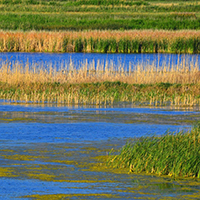
Clean Water Rollbacks
View the page for this story
The Trump administration’s latest rollback of Obama-era rules concerns the Waters of the United States, or WOTUS, policy, which had given the EPA authority to protect wetlands, small tributaries and ephemeral streams from pollution, industrial activities, and development. Vermont Law School professor Pat Parenteau explains to Host Steve Curwood what the rollback could mean for water quality and wetlands conservation across the country. (10:26)
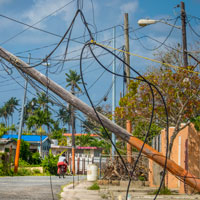
Rebooting Puerto Rican Power
View the page for this story
Two years ago, Hurricane Maria made a direct hit to Puerto Rico, killing thousands, destroying homes, and crippling the island’s energy infrastructure, which led to the biggest blackout in United States history when Puerto Rico’s fossil fuel-dependent grid went down. Bobby Bascomb reports on how the territory is working towards getting 100% of its electricity from renewable sources by 2050 in an effort to improve resiliency. (06:01)
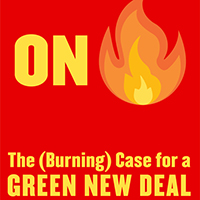
Naomi Klein’s Case for a Green New Deal
View the page for this story
The warming world is on fire – but so is the movement that’s calling for action, writes journalist and activist Naomi Klein. In her book On Fire: The (Burning) Case for a Green New Deal, she lays out a case for why the climate crisis presents an opportunity to address economic inequality, racism, misogyny, and other societal problems. Naomi Klein tells Host Steve Curwood climate disruption can no longer be addressed with just singular policies as only radical systemic change will work. (18:00)
Show Credits and Funders
Show Transcript
HOST: Steve Curwood
GUESTS: Alden Meyer, Naomi Klein, Pat Parenteau
REPORTERS: Bobby Bascomb, Peter Dykstra
[THEME]
CURWOOD: From Public Radio International – this is Living On Earth.
[THEME]
CURWOOD: I’m Steve Curwood.
The UN Climate Summit in New York City kicks off with a call to action from young activists.
BARRETTE: The climate crisis doesn't exist somewhere far in the future. The climate crisis isn't an issue for tomorrow. The climate crisis is the issue of our lifetime. We actually all know the climate crisis. We are all on a first name basis with the climate crisis. Sandy. Maria. Irma. Dorian.
CURWOOD: Also, two years after Hurricane Maria left Puerto Rico in the dark for months a call to modernize the electric grid with renewables.
GRIJALVA: You can’t just replicate what was there because that was not working. Dirty fuel is not the answer for the future of Puerto Rico. It is a diversified portfolio, alternative, renewable energy being part of it.
CURWOOD: We’ll have those stories and more this week on Living on Earth – Stick Around!
[NEWSBREAK MUSIC: Boards Of Canada “Zoetrope” from “In A Beautiful Place Out In The Country” (Warp Records 2000)]
[THEME]
UN Climate Action Summit
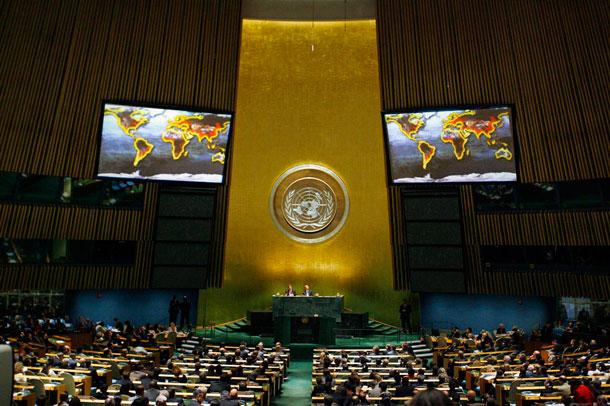
On September 23rd the high level agenda of the UN Climate Action Summit is scheduled to convene at the UN headquarters in New York City. (Photo: Flickr, United Nations Photo CC BY-NC-ND 2.0)
CURWOOD: From PRI and the Jennifer and Ted Stanley Studios at the University of Massachusetts Boston, this is Living on Earth. I’m Steve Curwood.
September 24th is the date of the United Nations Climate Summit in New York, called by the Secretary General, to ramp up action, but young people did not wait to speak out. Instead youth from at least 150 countries worldwide called for a series of Friday school strikes for the climate. And when school strike leader Greta Thunberg came before the US Congress on September 18th, she famously spoke for less than a minute to put the dire warnings of the 2018 report of the Intergovernmental Panel on Climate Change on the Congressional Record.
THUNBERG: I am submitting this report as my testimony because I don't want you to listen to me. I want you to listen to the scientists. And I want you to unite behind science. And then I want you to take real action.
CURWOOD: Jamie Margolin of Zero Hour also testified.
MARGOLIN: The reality is, my generation has been committed to a planet that is collapsing.
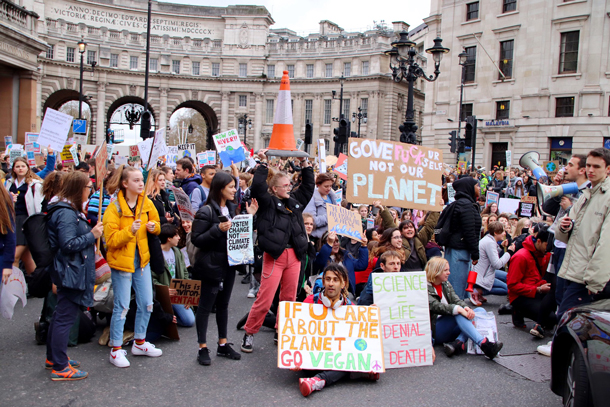
Organizers say 4 million people turned out around the world for the climate strikes on September 20th, 2019. (Photo: Roy, Flickr CC BY-NC 2.0)
CURWOOD: There is still some but not much time to avoid the worst impacts of climate disruption, and the UN summit gave leaders the chance to say how they are ramping up their ambition. Here to explain is Alden Meyer, Director of Strategy and Policy with the Union of Concerned Scientists. Thanks for joining us, Alden.
MEYER: Glad to be back with you again, Steve.
CURWOOD: So put the summit in perspective for us. I'm talking about the United Nations Climate Action Summit scheduled for Monday, September 23RD. The Secretary General has called that. Why is this so important?
MEYER: Well, let's go back to 2015, when the nations of the world adopted the Paris Agreement. At that time, there was an explicit acknowledgement that the pledges that countries had made out to 2030 under the agreement did not add up to the level of ambition that was needed to have any chance of meeting the temperature limitation goals world leaders signed off on there. As you remember, the goals in Paris were to hold the increase in global temperatures above pre-industrial levels to well below two degrees Celsius and to aim to get as close to 1.5 degrees C as possible. And all the analysis has shown that the current pledges put us on track for somewhere around 3 degrees Celsius or more. So in Paris, it was agreed that by the end of 2020 countries would be invited to indicate whether the pledges they had put forward in 2015 were their final answer, to quote the game show, or were subject to updating and revision. And that is the real political deadline here, the end of next year at the 26th meeting of the Conference of the Parties, which is going to be held in Glasgow, Scotland under the leadership of the United Kingdom. So the summit is really the attempt by the UN Secretary General António Guterres to jumpstart the political process of getting world leaders to come to grips with this huge gap in ambition between what they committed to in Paris on temperature and what they've put on the table in terms of national action plans.
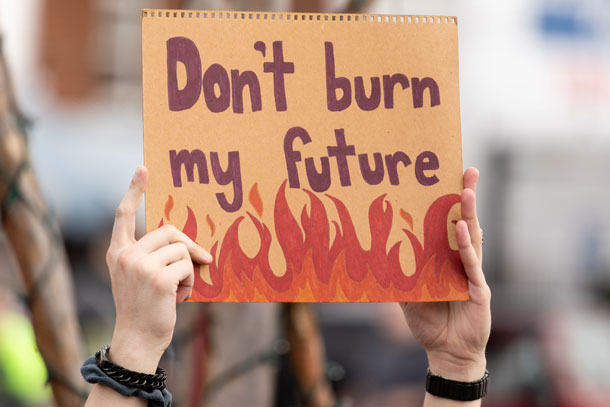
Leading up to Climate Week and following Climate Week are global, youth led climate strikes. (Photo: Flickr, Chesapeake Bay Program CC BY-NC)
CURWOOD: Now, back in June, Luis Alfonso de Alba, who was the Secretary General's Special Envoy on climate, told us that maybe about a third of nations seem to be willing to show their increasing ambition. How many more nations will we see disclose their increasing ambition on September 23rd? And what big emitters are among that group, do you think?
MEYER: Well, there's about 60, a little bit more than 60 countries on the current speakers list; that may change, it's a moving target. Most of the countries that have made a firm commitment to increase their ambition are developing countries, and most of those are small to mid size emitters. So you don't have most of the countries in the G20 group of countries, which constitute about 85% of global emissions collectively. And of course, the big two are the European Union and China. And the hopes are that they will commit to step up and both increase the ambition of their national, or in the European Union case, regional commitments in advance of COP 26 next year, and that perhaps they might hold hands and do that together in the way that the US and China jointly announced their targets in late 2014, which really jump started and built momentum for the final year of negotiations on Paris.
CURWOOD: To what extent is it possible we'll hear about such a deal on September 23rd of this year?
MEYER: Well, I think we will hear from each of those countries individually. The European Union, the new head of the European Union, Ursula von der Leyen, has indicated that she would like to see Europe increase its 2030 target from a 40% reduction, below 1990 levels to a fif-- at least a 50% reduction. But of course, she doesn't formally take office until November as the new president of the European Union. And this is going to be a process to get the entire 27 -- 28 member states with the UK --lined up around that goal. So that's Europe; hopefully by sometime next year, they will have their political ducks in a row internally and be ready to move. China's a much more complicated landscape because of course, China's in the midst of this trade war with the United States, their economy is slowing to some extent. They have the protests in Hong Kong. There's a lot of distractions on China right now. But they did just put out a statement today that I think was designed to show that they want to be a leader on this issue. And we'll see exactly what their representative says on Monday at the summit.
CURWOOD: So what's the general mood? How are the folks around the Secretary General feeling things will go on Monday?
MEYER: Well, I think they're feeling it's going to be a good show, not just from the countries that are prepared to step up, but there are a number of what they call thematic groups or coalitions, working on issues like nature based solutions, cities and infrastructure, energy systems, transportation, climate finance. And of course, all this is happening in the context of the youth climate strikes, which are going to happen the Friday before the summit, the Friday after the summit. This is gaining huge momentum and really picking up traction and putting pressure on national leaders and quite a few countries to up their game.
CURWOOD: Now, you've been following this process for more than three decades. To what extent do you think we'll see a lot of nations enhancing their climate action plans before the deadline next year, the 2020 deadline?
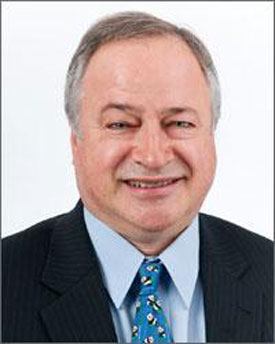
Alden Meyer is the Director of Strategy and Policy with the Union of Concerned Scientists. (Photo: Union of Concerned Scientists)
MEYER: I think the chances are pretty good that you'll get a critical mass of countries doing that. Obviously not all countries; you're not going to see the United States, for example. You're probably not going to see it in Brazil, where President Bolsonaro has been sending signals that he does not want to enforce deforestation restrictions on ranchers and farmers that are cutting down and burning the rainforest. You know, and there's a few other countries; Russia, we’re not clear if they're going to do anything really significant before next year's deadline, and Saudi Arabia, a few others. But if you look at the big developed countries, I think the prospects are good, you can see movement. The question is going to be how much? How fast? And will it really change the trajectory that we're on right now, which, as I said, is leading us to probably 3 degrees Celsius or higher by the end of the century.
CURWOOD: Alden, you've been at this a while; what’s your level of hope at this point in this process?
MEYER: Well, I mean, it's, it's always a strange mix, as we've talked about before, Steve, of hope and despair. And, you know, the hope is really coming from the momentum that we see, particularly at the sub-national level, cities and businesses and states and others making truly transformational commitments to get to net zero emissions, to get 100% renewable energy, and other goals. It's coming from the youth movement, which I think is providing much needed political momentum and energy in many countries around the world and really challenging our generation to look ourselves in the mirror and say, can't we do better? So there are real grounds for hope. And as we discussed earlier, the dramatic continuing reductions in the cost of the clean energy and other solutions to the climate problem. The despair comes in, in the sort of inertia in the political system and, and the inability of many leaders around the world to truly come to grips with the scale and urgency of this crisis and to move as quickly as the science says we need to if we're going to avoid truly catastrophic impact. So we're sort of in a race with the physical climate system. And right now, we're losing. But we know that the transformations can happen very quickly if you have sufficient political will. And as former Vice President Al Gore is fond of saying, political will is a renewable resource. So, you know, that's what gives me grounds for hope and why I stay in fighting on this after 30 years in the trenches, because, you know, there are grounds for hope.
CURWOOD: Alden Meyer is the Director of Strategy and Policy with the Union of Concerned Scientists. Alden thanks so much for taking the time with us again.
MEYER: Glad to talk to you, Steve.
Related links:
- More about Climate Week NYC 2019
- More about the United Nations Climate Action Summit 2019
- More about the Youth Climate Strikes
- More about Alden Meyer
[MUSIC: Sol y canto, “Peace Will Come/Pas vendra” on El Doble De Amigos/Twice As Many Friends, by Tom Paxton, Rounder Kids Records]
Beyond the Headlines
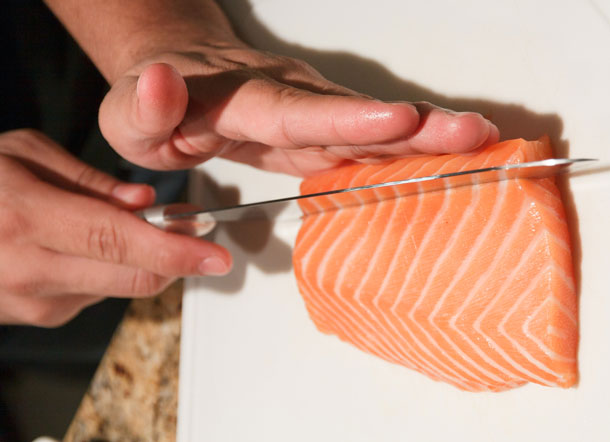
A recent study shows that the edible parts of fish can contain microplastics, which may influence the amount of plastic that makes its way back into the human body. (Photo: Ethan Trewhitt, Flickr, CC BY-NC-ND 2.0)
CURWOOD: It's time now for us to take that little peek beyond the headlines with Peter Dykstra. Peter's an editor with Environmental Health News, that's EHN.org and DailyClimate.org. And we've got him on the line, I think, from Atlanta, Georgia. Hey there, Peter, are you there?
DYKSTRA: I'm here. How you doing, Steve?
CURWOOD: I'm doing all right. And what do you have for us today?
DYKSTRA: You know, we used to think that microplastics, those tiny little shreds of the single-use plastic bags and bottles and everything else we throw away, when they made it to the ocean and were ingested by fish, that they just stayed in the digestive systems of those animals. There's some new research suggesting that those tiny particles, actually, in many cases end up in the flesh of the fish. And of course, we take the fish out of the water, we eat the flesh and bring the microplastics back, a very odd turn on recycling.
CURWOOD: Wait a second. So if I have grilled salmon, I'm getting a side order of plastics with it?
DYKSTRA: Just a note, just a drizzle, just a taste of plastic, along with that delicious salmon.
CURWOOD: Hey, what else do you have for us today?
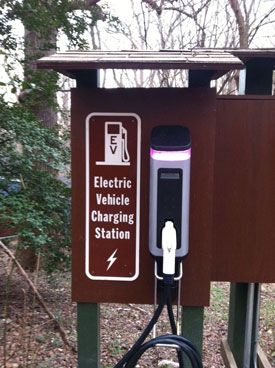
Various states have initiatives to encourage the use of electric vehicles, such as tax credits or increasing the availability of charging stations. Opponents have since conjured up the concept of “Freedom to Drive” as a rallying cry to push back against such initiatives. (Photo: Mrs. Gemstone, Flickr, CC BY-SA 2.0)
DYKSTRA: Well, there's another round in the century-long battle of the oil industry versus the electric car. EVs could make up, we're told, nearly half of all the passenger cars and trucks on the road by the year 2040. But the oil and gas companies, as they've done in the past, want no part of that.
CURWOOD: Peter, so how are they pushing back?
DYKSTRA: A lot of legislative stuff has come up, particularly on the state level, in efforts to encourage the use and sale and recharging of electric vehicles in places like Colorado, Maryland, Kansas, and here in Georgia. Either tax breaks or other things to make it easier to own and operate EVs have gone by the boards, or at least been challenged by groups like the American Petroleum Institute and Americans for Prosperity.
CURWOOD: So, when these groups mount campaigns, they tend to come up with catchy phrases. What are we hearing this time?
DYKSTRA: 'Freedom to Drive'. Just like freedom to smoke, freedom to get your head bashed in without a seatbelt or a motorcycle helmet, "Freedom to Drive" is the rallying cry to limit tax credits for EVs in order to have the freedom to use fossil fuels in the future.
CURWOOD: You gotta wonder, if this trouble with Saudi Arabia in the Middle East continues, the price of oil is going to go up. Gasoline is gonna make electric cars look better to consumers, huh?
DYKSTRA: Prices are going to go up and down with any change or any instability in the world. I can't see the Iranians or the Saudis doing a proxy war over windmills or solar farms.
CURWOOD: Indeed, hey, what do you have from the history vault for us today?
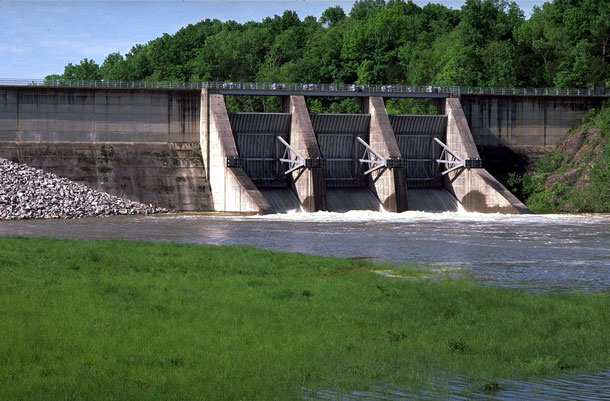
In 1979, President Jimmy Carter offered an exemption to the Endangered Species Act for the Tennessee Valley Authority’s Tellico Dam. (Photo: Tennessee Valley Authority, Wikimedia Commons, Public Domain)
DYKSTRA: 40th anniversary, let's go back to September 25, 1979. President Jimmy Carter, under heavy pressure, signed a bill offering an exemption to the Endangered Species Act for the Tellico Dam, proposed by the Tennessee Valley Authority. There was a small endangered fish called the snail darter. That little fish is all but forgotten. But it was the first time there was a major focus on one species stopping a major project. Fast forward a few years later in the early 80s, another one was the northern spotted owl, which put some old growth forests in the Pacific Northwest off limits for loggers.
CURWOOD: So how did that affect the view of environmental activists of President Jimmy Carter?
DYKSTRA: Well, he threw the fish under the bus. But overall, Jimmy Carter is remembered as one of the better environmental presidents in recent years, he did a great deal to focus on some of the things we're now dealing with in the present tense.
CURWOOD: Peter Dykstra is an editor with Environmental Health News, that's EHN.org and DailyClimate.org. Thanks, Peter. We'll talk again real soon.
DYKSTRA: All right, Steve, thanks a lot. Talk to you soon.
CURWOOD: And there's more on these stories at our website LOE.org.
Related links:
- The Food and Environment Reporting Network | “Today’s Special: Grilled Salmon Laced With Plastic”
- POLITICO | “The Oil Industry vs. the Electric Car”
- The New York Times | “Carter Assailed on Dam Periling the Snail Darter”
[MUSIC: Sol y canto, “A Volar Cometas!/Let’s Go Fly Kites!” on El Doble De Amigos/Twice As Many Friends, by Brian Amador, Rounder Kids Records]
CURWOOD: Coming up – The Trump administration moves to roll back rules to protect wetlands. That’s just ahead on Living on Earth.
ANNOUNCER: Support for Living on Earth comes from Sailors for the Sea and Oceana. Helping boaters race clean, sail green and protect the seas they love. More information at sailors for the sea dot org.
[CUTAWAY MUSIC: Rob Curto’s Forro For All, “A Voz da Razao” on Forro For All, by Osvaldo Oliveira, self-published]
Clean Water Rollbacks
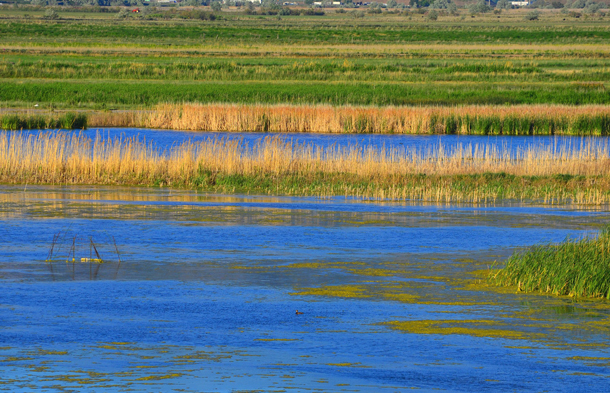
Wetlands serve as important habitat and provide ecosystem services like carbon sequestration, water storage and water purification. (Photo: LivingLandscapeArchitecture, Flickr, CC BY-SA 2.0)
CURWOOD: It’s Living on Earth, I’m Steve Curwood.
Wetlands are ecological powerhouses that clean our water, take up carbon dioxide, and provide habitat for birds, young fish, insects and so much more. The United States has already lost about half of its wetlands since the 1700’s. And we could lose still more, thanks to a Trump administration rule rollback. The Waters of the United States, or WOTUS rule, gave the Environmental Protection Agency authority to regulate any flows upstream of the nation’s major rivers and lakes. Here to explain what’s at stake is Pat Parenteau of the Vermont Law School. Pat, welcome back to Living on Earth!
PARENTEAU: Good to be with you, Steve.
CURWOOD: Pat, we need a brief refresher here. What kind of waterways was the Obama administration's Water of the United States, or WOTUS, rule meant to protect?
PARENTEAU: Well, the big controversy was over what are called headwater streams. These are obviously the places where the larger river systems -- think Missouri River, Mississippi River, and so forth -- begin. And the Obama administration was trying to clarify how far up into the watershed federal regulation would go. They were trying to capture sources of pollution, and also sources of drinking water. Fully two-thirds of the areas that they identified for federal protection are source water areas for public water supplies. So that was the driving force, they did a lot of scientific analysis of the importance of these smaller headwater streams. And of course, in the western United States, a lot of the streams are what we call ephemeral; they don't flow year-round, they flow in response to heavy rain or snow melt. And so the Obama administration was simply following the science from their, their point of view, and saying, if we're going to protect the waters downstream, the big lakes and rivers, we're going to have to go up into the watershed and protect those areas that feed down into the bigger water.
CURWOOD: I guess if you have garbage in, you're going to get garbage out to the main water.
PARENTEAU: Yeah, that's kind of the system. That's a hydrologic cycle. That's what that word means, things are in a system. And the Obama administration's approach was to look at watersheds as a system and go where the pollution was.
CURWOOD: Remind us, Pat, why these water systems are so important. Yes, we need drinking water, and...?
PARENTEAU: Oh, yeah, so the wetlands in particular, that's, that's the one category of waters that has been really reduced in what the Trump administration is proposing. They perform all kinds of important services, they're naturally flood control. And you think about the kinds of record flooding we've been seeing, particularly this year; there's still flood conditions five months after those heavy rains in the spring. You know, wetlands are sponges, and they soak up that excess water and help protect downstream communities. Wetlands also take up a lot of pollutants. If you think about nutrient pollution, which is causing these awful algal blooms around the country with some cyanobacteria involved with it, which is a public health threat. Those kinds of conditions are threatening public water supplies, for example, the city of Toledo, Ohio, and Lake Erie. And so wetlands are a great source of protecting drinking water sources. And then wetlands also provide habitat for fish and wildlife; they're carbon sinks that help deal with climate change issues. So they have an awful lot of really important services for human beings. And without federal protection, the majority of states don't have laws that restrict filling and draining and pollution in wetlands. So it's either the federal government or nothing in some places.
CURWOOD: Please give me an example of a region or a state that could really get hit hard in terms of public and ecological health with this.
PARENTEAU: Yeah, well, Arizona would be, you know, Exhibit A on that score, because 90% of Arizona's waterways are what are called either intermittent or ephemeral, which simply means they don't flow all the time. And some major river systems like the Santa Cruz River dries up. I know, I've been there, and I've seen it -- I think, maybe you have, too, Steve -- but flows right through Tucson, Arizona; but it's dry major portions of the year. So, big question mark, about whether even big rivers like that, that dry up periodically for extended periods of time, would still be covered. What the Trump rule is saying is that if the only thing that's causing the flow in the river is a major rain event, then it's not covered, it's considered ephemeral. So all throughout the semi-arid West, you're going to see major loss of federal protection and regulation for these waterways.
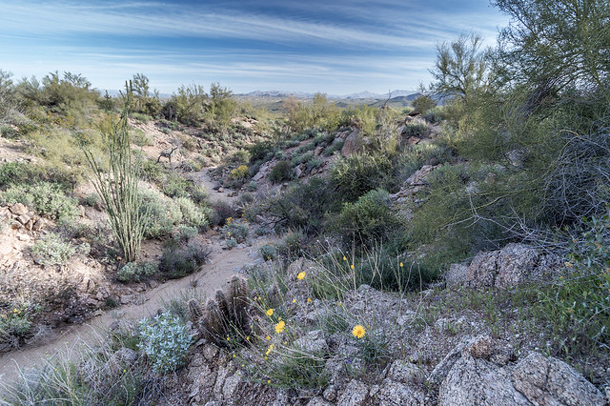
Dry washes that are only wet during or after rain events would not be included in the Trump administration’s Waters of the US definition. (Photo: Dominic Paulo, Flickr, Public Domain)
CURWOOD: So who's been pushing for this rollback of the Waters of the United States rule?
PARENTEAU: Well, the Farm Bureau has been kicking the mule, as they say on this one. They've been the ones that have really gone after the clean water rule, and now are cheering in support of Trump's repeal of the rule. The Association of Home Builders is close behind. They have a lot of sprawl development going on around the country in streams and wetlands. And they are opposed to strong federal permit requirements that stall their development. So those two, I think, are the chief protagonists in this one.
CURWOOD: So, given this rollback of this Waters of the United States rule that the Trump administration has announced -- should it stick, what kinds of activities would farms and industries be allowed to do on wetlands that were previously protected?
PARENTEAU: Well, you know, they're going to be able to discharge pollutants from pipes and ditches and a variety of what we call point sources, as long as they move that point of discharge above where the proposed new mark, the new rule is going to say federal jurisdiction ends. And then you have this argument that the Trump administration is making -- "well, but the states will pick up the slack, they'll step up and start regulating those sources that we no longer will regulate." But when you look at the laws of these various states, what you find is that over half of the states have laws on their books which say they will not regulate beyond what the federal Clean Water Act requires. "No stricter than federal," is the way they put that. And no surprise, the states that are arguing for the Trump administration to remove federal protection happen to be those very same states that have laws saying we will not go further than what the federal law requires us to do. So this is going to leave a huge gap in major areas of the country, where we will not have significant regulation to protect these water sources. And the job will be for people to try to lobby their state legislatures to restore some of that protection. Unless, of course, the courts step in here and stop some of this Trump rollback. And then a new administration may come along and restore some of these protections. But right now, we're in kind of a chaotic situation, frankly.
CURWOOD: What other kinds of activities would be allowed if this rollback of the Waters of the United States goes forward?
PARENTEAU: Well, you know, spills of oil and hazardous substances that do occur on a chronic basis, from oil pipelines, gas pipelines, containment tanks, and other kinds of structures that contain these potentially toxic and hazardous materials. The Clean Water Act has a program to deal with those spills, both requiring spill prevention and containment and clean up requirements, but also liability, significant liability for failure to prevent and deal with spills and leaks. And that all depends on whether or not these waters that remain after the Trump rollback are going to be covered by that requirement. So you could see pipelines crossing wetlands and streams that are no longer subject to the Clean Water Act, and therefore, the spill containment requirements wouldn't apply. So there's a whole category of industrial activity that depends on the definition of the waters that are covered by the Clean Water Act.
CURWOOD: What about mining?
PARENTEAU: Mining, the same thing. If you're mining in headwaters -- I'm dealing with a big copper mine in Arizona right now where they're in, you know, very high in the Santa Rita mountains. These are incredibly important, biologically important areas. They're called the Sky Island habitats. They even have habitat of the jaguar -- one or two, anyway; jaguars that travel up from Mexico. So these are high quality areas, but the water that flows through them is ephemeral. It's these intermittent streams. But that's all the water there is, in these systems. And what Trump is proposing would mean copper mining, this massive copper mine a half a mile deep, mile across, would be exempt from any kind of requirement for dealing with pollution and de-watering of these streams. So lots of different impacts, some of which you can foresee, some of which will be hard to foresee.
CURWOOD: And how correct is it to say with this rollback of the Waters of the United States that developers are going to be able to, well, literally destroy areas that are not considered wetlands?
PARENTEAU: There's all kinds of wetlands that don't have this "continuous surface connection" that the Trump rule is requiring. And in fact, many wetlands are fed by groundwater; some wetland areas are the result of an overflow from a lake or a river; you think the Lower Mississippi River, most of those great bottomland hardwoods swamps, they're wet because the Mississippi River overflows its banks, has traditionally and is even more so now. And if you take away protection for some of those areas, you're removing some of the most important biological resources in the country. We've already destroyed 55% of the wetlands that used to exist in the United States. So every last wetland we have is doing all the wonderful things that wetlands do. But if they don't have federal protection, it's going to be hard to keep them in place.
CURWOOD: Pat Parenteau is a former general counsel for the regional office of the Environmental Protection Agency; he's now a Professor of Environmental Law at Vermont Law School. Pat, thanks for taking the time with us today.
PARENTEAU: Oh, you're welcome Steve. Enjoyed it.
Related links:
- NYTimes | “Trump Administration Rolls Back Clean Water Protections”
- About Pat Parenteau
[MUSIC: Mike Marshall and Darol Anger, “Dolphins” on Windham Hill: The First 10 Years, disc 2, by Michael Marshall, Windham Hill Records]
Rebooting Puerto Rican Power
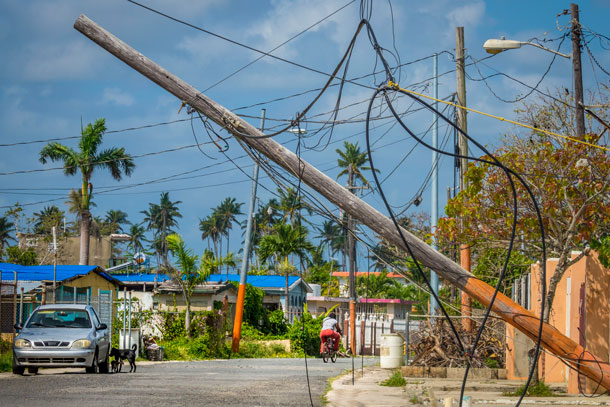
After Hurricane Maria Puerto Rico’s electric system was highly damaged, leaving some communities without electricity for more than 100 days. (Photo: Preston Keres, USDA, Flickr, Pubic Domain)
CURWOOD: It’s been two years since Hurricane Maria slammed ashore in Puerto Rico, killing more than 3,000 people and leaving a trail of devastation in its wake. Among many losses, the centralized electricity grid was wiped out, meaning the entire island was without power. Before the storm more than 90 percent of the island’s electricity came from imported fossil fuels. But on a tropical island with year-round sunshine and wind, Puerto Ricans are now looking to renewables as a more resilient energy source. And the Puerto Rican government has pledged to rebuild the grid using 100 percent renewable energy by 2050. Living on Earth’s Bobby Bascomb has our story.
BASCOMB: The day Hurricane Maria hit Puerto Rico it changed the life of community organizer, Christine Nieves.
NIEVES: It felt like the world had ended, but it also felt incredibly empowering. It was the darkness of the end of the world and it was the darkness of also the beginning of something.
BASCOMB: And Christine’s way out of the darkness was through a solar powered microgrid, which was up and running at the community center within a couple months while the rest of the town was in the dark for nearly a year. The community center became a place where residents, mostly retired and living alone, were able to get out of their dark homes and meet friends, charge their phones, and cook together. I met Christine at the community center nine months after the storm where volunteers were busy preparing rice, vegetables, and meat over an industrial gas stove. But the walk in refrigerator and lights were powered by solar panels on the roof. Christine says having this microgrid setup was a game changer following the storm and she’d like to see more decentralized renewable energy on the island.
NIEVES: I think it would be good for Puerto Rico because it would be not only clean energy, but it’d be more resilient.
BASCOMB: Democratic Congressman Raul Grijalva of Arizona, chair of the House Natural Resources Committee, agrees.
GRIJALVA: I don't want the utility company, or any of the policies in PROMESA to get locked in to fossil fuels as the source for energy generation, okay? Dirty fuel is not the answer for the future of Puerto Rico. It is a diversified portfolio, alternative, renewable energy being part of it. And what I don't want to get is locked in to long term commitments on coal purchases, or any other fossil fuel generated energy source.
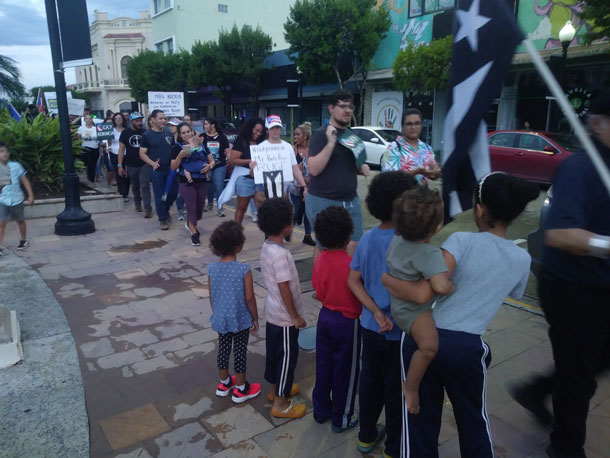
People marching in the streets of Mayaguez, Puerto Rico on July 19, 2019 to demonstrate in favor of a decentralized energy grid. (Photo: Marcel Castro, @MarcelJCastro, Twitter)
BASCOMB: Congressman Grijalva, who is a powerful member of the Congressional Hispanic Caucus, says he will soon be proposing major changes to Puerto Rico’s PROMESA law which was passed in 2016 to address the island’s debt crisis. Among the changes he will propose is the creation of a reconstruction coordinator to oversee recovery from Hurricane Maria. Mr. Grijalva says he doesn’t want to just repair the current infrastructure, but improve it.
GRIJALVA: You can't just replicate what was there because that was not working.
BASCOMB: The Puerto Rican Electric Power Authority, or PREPA, is the only electric utility on the island and has been accused of corruption in their handling of the post-Maria electricity restoration. Executives are accused of restoring power to their own homes before hospitals and airports. There are also accusations of accepting bribes, in one case from an exotic dance club, in return for a speedy response from the utility while leaving communities like Humacao waiting in the dark for nearly a year. Congressman Grijalva says there needs to be a major institutional change within the utility.
GRIJALVA: A lot of transparency needs to happen around that utility. And a lot of accountability has to happen around that utility. So we don't see it as a political dumping ground – which, accusation is that's what it has become and was. To one that is taking care of the consumer on the island, and in doing so is transparent and open about how it does its business, I think that's going to be critical too.
BASCOMB: Fernando Padilla is director of PREPA’s Project Management Office.
PADILLA: The public opinion and the public perception is that PREPA no longer serves the best interest of them. That’s why we are taking these steps forward in order to transform the company and bring in a different, a different solution.
BASCOMB: Indeed, Puerto Rico recently passed a plan to use 100 percent renewable energy by 2050, mostly from solar power. But there are plans to invest in new infrastructure for natural gas, which Mr. Padilla says is a necessary bridge fuel between the diesel, coal, and oil that fuels Puerto Rico now.
PADILLA: Natural gas brings us the elements of cost, of execution, and also the reliable power that the people of Puerto Rico need.
BASCOMB: But Marcel Castro-Sitiriche, a professor of electrical engineering at the University of Puerto Rico, says the PREPA plan has the wrong priorities.
CASTRO-SITIRICHE: Basically we need to flip around the process. First look at how much we can get with small systems in the rooftop of houses and business, and then look for utility-scale solar with energy storage, and then we see what we cannot fulfill with these two options. And we may still have to install new generating capacity with fossil fuels, but that has to be the last option.
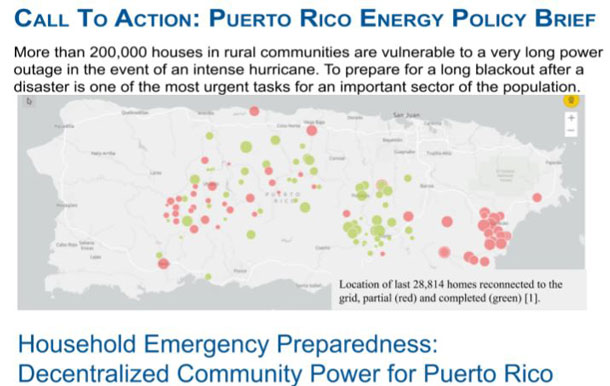
Marcel Castro, a Professor at the University of Mayaguez, created a policy brief outlining the importance of providing rural communities in Puerto Rico with solar rooftop home systems with batteries. (Photo: Marcel Castro, @MarcelJCastro, Twitter)
BASCOMB: Professor Castro-Sitiriche says studies suggest there is enough solar capacity on existing rooftops in Puerto Rico to power the entire island with solar. Of course, 165 mile-an-hour winds can easily rip the solar panels off a roof, but Castro-Sitiriche says that’s yet another reason to invest in this type of distributed energy.
CASTRO-SITIRICHE: Because, for example, if you have a small solar system of six to eight panels on your house, it is reasonable to arrange for two healthy adults to bring those panels down before the hurricane.
BASCOMB: And then easily put them back up after the storm passes.
CASTRO-SITIRICHE: If we start from the bottom up, then we start building more distributed resiliency into the communities.
BASCOMB: And that need for resiliency is something that nearly everyone in Puerto Rico can agree on. For Living on Earth, I’m Bobby Bascomb.
CURWOOD: We’ve assembled the stories Bobby reported from Puerto Rico into a special feature on our website. Please check it out at LOE dot org.
Related links:
- NPR | “Puerto Rico Harnesses the Power of the Sun for a Renewable Energy Future”
- Marcel Castro-Sitiriche's Twitter
- Bloomberg | “Grijalva to Propose Changes to Puerto Rico Promesa Law”
- City Lab | “No, Puerto Rico’s New Climate Change Law is Not a ‘Green New Deal’”
[MUSIC: Sol y canto, “Banana” on El Doble De Amigos/Twice As Many Friends, traditional Jamaica/Nicaragua, Rounder Kids Records]
CURWOOD: Coming up – writer Naomi Klein makes the case for a Green New Deal. That’s just ahead on Living on Earth.
ANNOUNCER: Funding for Living on Earth comes from you, our listeners, and United Technologies, combining passion for science with engineering to create solutions designed for sustainability in aerospace, building industries, and food refrigeration. UTC companies such as Otis, Carrier, Pratt and Whitney, and UTC Aerospace systems are helping to move the world forward. You can learn more about United Technologies by tuning into the Race to Nine Billion podcast; listen at racetoninebillion.com. This is PRI, Public Radio International.
[CUTAWAY MUSIC: Mike Marshall and Darol Anger, “Dolphins” on Windham Hill: The First 10 Years, disc 2, by Michael Marshall, Windham Hill Records]
Naomi Klein’s Case for a Green New Deal
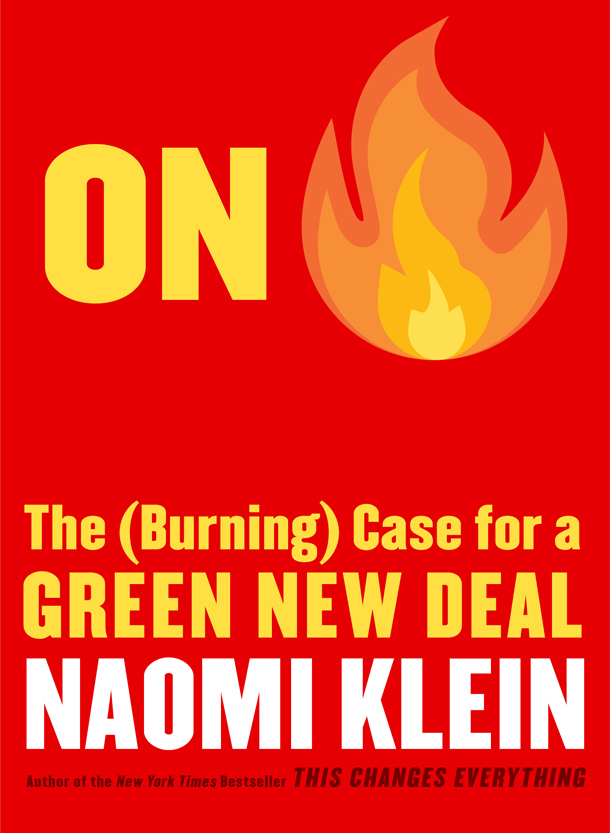
On Fire: The (Burning) Case for a Green New Deal gathers some of Naomi Klein’s essays written over the past decade, as well as new writing. (Image: courtesy of Simon & Schuster)
CURWOOD: It’s Living on Earth, I’m Steve Curwood.
We’ve been here before, and we’re here now. Esteemed scientists sound alarms of impending warming disasters. Climate activists take to the streets. Politicians talk about climate disruption and offer policies to address it. And in 2015, world leaders even came together to sign an historic pact to curb emissions. Yet climate-warming emissions have surged to record levels. And the world continues to warm. So some say nothing short of systemic change will snap us out of this failed loop and a sustainability reboot of the economic system could also remedy the problems of racism, misogyny, and economic inequality. In her book, On Fire: The (Burning) Case for a Green New Deal, climate activist and writer Naomi Klein lays out why the climate crisis cannot be solved without complete change. She joins me now from New York. Naomi, welcome back to Living on Earth!
KLEIN: So great to be with you again, Steve.
CURWOOD: So how fair is it to say that your book makes the argument that we cannot succeed in addressing the climate emergency unless we do do something like a Green New Deal?
KLEIN: Well, that's the argument I make. And in fact, this is what we have heard from the leading climate scientists, most recently from the Intergovernmental Panel on Climate Change and the 1.5 report that came out a year ago, where they said that if we are going to stay below 1.5 degrees, which they strongly recommend that we do, then it will require unprecedented transformation in virtually every aspect of society. That is a quote from the summary of their report. So you know, we've, we've talked so much and done so little, when it comes to lowering emissions, that now the things that we must do in the face of accelerating climate destabilization are so profound, that we can't think of it in terms of a singular policy anymore. We really are talking about building the next economy, on a deadline.
CURWOOD: So what lessons could a Green New Deal take from FDR's New Deal?
KLEIN: Well, I think that we can take both inspiration and harrowing warnings from the original New Deal. So let's start with the warnings first. The original New Deal excluded many, many Americans. Many African American workers were excluded. Women workers were excluded; domestic workers; agricultural workers were excluded. The truth is, the most vulnerable, least protected workers in the workforce were sacrificed to get this thing through. There was also segregation, I mean, this was Jim Crow America. So you had the CCC camps, the Civilian Conservation camps. They were almost all male; there was one women's camp. Actually, Eleanor Roosevelt wanted women to be full participants in the CCC, but they only got one camp and they specialized in canning over there.

A Civilian Conservation Corps team takes a break from constructing park buildings, c. 1939. (Photo: Richard, Flickr CC BY 2.0)
CURWOOD: Well, that doesn't sound like very good news! What's the upside of FDR's New Deal?
KLEIN: Well, I foreground the warnings because I think they, they do tell us that if justice, if racial justice, gender justice, economic justice isn't at the center, and in front of mind, we have every reason to believe we would make the same sorts of political calculations. But here's why I don't think we just throw the whole thing out, okay? Because the New Deal reminds us that it is possible to do very big things, many of them really very exciting, like planting 2.3 billion trees, or having a artistic Renaissance, public funding for the arts. And those parts of the, of the New Deal actually were very forward-looking when it came to gender and race. They remind us that when we come together with boldness, we can change a whole lot. And I think that that is incredibly important because when you talk to people about climate change right now, climate change denial is receding. Climate change hopelessness, climate change doomsaying, a sense of inevitability, that there's nothing we can do -- that is rising. And I think it's rising because we have been told a story about the kinds of human beings we are, that we're incredibly short-sighted, that we're hyper-individualistic, we only just care about gratifying our, ourselves in the short term. And so if that's all we are, if we're not capable of coming together and seeing a big picture and working together, then we really are doomed. And the New Deal and also, you know, wartime transformations during the Second World War, where we saw the proliferation of Victory Gardens, where people changed, you know, the way they move themselves around, stopped using cars for leisure driving, started using public transit, and on and on. They remind us actually, that it is possible to change very quickly with the right kinds of political leadership. And when it is designed in a way that is perceived as just.
CURWOOD: Talk to me a little bit more about the arts that emerged during FDR's New Deal; you write at some length about that in your book.
KLEIN: Yeah, I, I do, because I think that part of the barrier that we're up against is really a barrier of the imagination, that after a certain point, when we've only seen one version, or variations on the same version of climate apocalypse, it starts to feel like a foregone conclusion. So I think we need to awaken the utopian imagination, the idea that actually we can be many things. And so, you know, I quote different sci-fi writers who talk about that utopian imagination, including Ursula Le Guin. And I write about the experience that I had, being part of a little film project with Representative Alexandra Ocasio-Cortez and the wonderful visual artist, Molly Crabapple, where we decided to make a short film that was titled "A Message From the Future With Alexandria Ocasio-Cortez." It's set an indeterminate number of years in the future, after we have already won a Green New Deal. And it paints a picture of this world transformed. And thanks to Molly's just incredible paintings, it's, you know, it's a very beautiful place. And you know, and it's not, it's not all good; we talk about the time that a hurricane wiped out large parts of Florida. But it talks about the change in values and how people came together and didn't turn on each other. So I think artists have a really important role to play in helping us imagine the future that we need and breaking through this sense of sort of apocalyptic inevitability. I also think we should recognize that art is low carbon, you know, there's lots of, you know, putting on a play can be low-carbon work; painting a mural with a bunch of kids in the neighborhood as, you know, there were so many thousands of them during the New Deal era, that's low-carbon work. You know, when we think about a green job, we often think about a guy in a hard hat, putting up a solar panel. And that is great, and we need lots of those jobs, and we need to make sure they're unionized jobs, and they pay workers a fair wage. But, you know, caring for kids is also low-carbon. Teaching kids is low-carbon. Caring for the sick is low-carbon. And like I said, making art is low-carbon. So part of what I'm writing about in the book is how we need to expand the care sectors, and other low-carbon sectors that really improve quality of life. Because people have gotten this idea in their heads that responding to climate change is all about loss, all about deprivation. And it is true that there are things that we are going to have to contract when it comes to wasteful forms of consumption. But there are also activities that are already low-carbon, do improve our quality of life more than anything else, like access to art in nature, having good schools for our kids, taking care of each other. And we can make them even more low-carbon if we do this right.

Making art can be low-carbon, Naomi Klein points out. A Green New Deal could support artists just like President Franklin Delano Roosevelt’s New Deal did in the 1930s. (Photo: Yufifalato722, Wikimedia Commons CC BY-SA 4.0)
CURWOOD: So FDR, his New Deal was top down; the World War II mobilization was very much top down. How do we actually implement a Green New Deal today, when our political structure's kind of wobbly from the top down?
KLEIN: Kind of. Yeah. [LAUGHS] Well, you know, I would say that, you know, it's certainly true that the World War II mobilizations were very top down. And there were parts of the New Deal that were very top down. But it's also true that the New Deal was a process, a push and pull from above and below, right? What we see in the periods when these programs, you know, they call it, you know, sort of the "alphabet soup" agencies of, you know, WPA and so on. When they were being rolled out, this was a period of intense work or mobilization in the United States. There was a huge spike in strikes in 1934, '35, '36, '37. So all throughout the period where FDR's administration is doing more and more, and quicker and quicker, they're facing a huge amount of pressure from organized working class people who are saying, "We need more, this isn't enough, what you're doing is only a start, we need more protections." So I think there's a very important lesson, that this can't be something that is just handed down from any political party. You know, I think this only happens on a federal level if there is a new administration in place in 2020. But we also don't have to wait. I mean, there's a huge amount, there are Green New Deal projects that are getting kicked off in large cities in the United States, in states like New York and California, and we need to be pushing for the states that can to do more. And then we also need, I think, to be ready to stay organized, no matter who is in the White House in 2020.
CURWOOD: Of course, the Green New Deal is criticized by some as a left-wing wish list, left wing revolution, really, to take away private property and turn America into some sort of socialist place. How do you respond?
KLEIN: Well, a couple of ways. One is that we have been trying over the past couple of decades to address the climate crisis, to address the crisis of soaring emissions, within the confines of a sort of market logic, right? So we have a cap and trade system in California; there are countries that have introduced carbon taxes. I'm originally from Canada, we have a carbon tax that many people look to as an example, in British Columbia. If you look at the territories that have done this, you see some marginal improvements over doing nothing. But what you don't see is anything like the emission reductions that scientists are telling us we need to do, right? I mean, British Columbia, this model carbon tax-- emissions have gone up in British Columbia almost every year except one that the carbon tax has been in place. And the year that they went down, it was because of the global recession, it wasn't because of the tax. I think there is an opening, a political opening, a willingness to talk about deeper change, which we see in the Democratic primaries, you know, in a willingness to talk about regulating corporations, and a willingness to talk about Medicare for All, and direct job creation. And so I think many of the climate solutions that, frankly, were obvious to many of us writing about this for years, but were treated as politically, sort of untouchable for many years. Now, there's just more political space to talk about the real solutions, because there is a sense that this whole system is kind of failing people on multiple fronts. So the Green New Deal is a holistic vision that connects the dots between economic insecurity, lousy jobs that don't pay a living wage, systemic injustices of all kinds and says, Okay, let's multitask here. Let's find a way to radically lower emissions in line with science in a way that is going to close all of these systemic inequalities.
CURWOOD: So UN Secretary General António Guterres has called leaders from government, business, civil society, everyone to come to the Climate Action Summit in New York, and to have nations put forward how they're going to ramp up their Paris Agreement emissions reductions commitments. How hopeful are you about what they'll be able to offer?
KLEIN: I think every national context is different. I think the young climate strikers are really putting a lot of pressure on their leaders to come to the table with more than nice words. You know, it's, it's significant that Greta Thunberg, who kicked off this wave of climate youth activism -- there's been young people involved in the climate movement from the get go, but there's definitely a new wave that began with her decision to go on strike from school, now there are these strikes every Friday. And it's significant that Greta comes from Sweden. You know, I mean, here in the US, we, we often invoke Sweden as a country with much better green policies than we do. But you know, Greta's saying, well, you talk a good game, but I'm looking at the emissions and it's nowhere in line with what you're saying needs to happen in terms of, you know, keeping our temperatures below 1.5 to 2 degrees Celsius. And so I think it'll be interesting to see the dynamic. I think these leaders know they're being watched by their own kids in a way that is actually quite new.
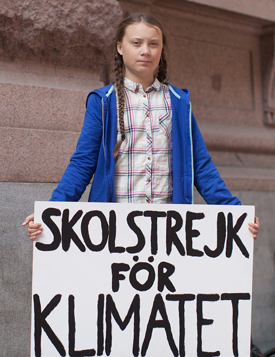
Sixteen-year-old Swedish activist Greta Thunberg ignited the Fridays for Future youth climate strike movement. (Photo: Anders Hellberg, Wikimedia Commons CC BY-SA 4.0)
CURWOOD: Naomi, if you look at the planet, about 80% of the planet's people are brown. And if you look at the emissions, the bulk of the emissions have come from the white part of the world. To what extent is the climate emergency a symptom of white supremacy?
KLEIN: Well, I think it absolutely is. I mean, even the fact that it has not been treated as a crisis is a reflection of the fact that the people in the teeth of the crisis already are overwhelmingly black and brown people. So it reflects a discounting of lives. Even setting the temperature target of two degrees Celsius, several years ago; when that happened, African delegates stormed out of the UN meetings and called it a genocide, because they said Africa can't survive that level of warming. So I think every way that we have responded or failed to respond to the climate crisis has reflected a discounting of black and brown lives, and continues to this day. And what really worries me is that I think the days of overt climate change denial are numbered. And I think we're starting to see people on the far right, who are openly racist, embrace an ideology that some are even calling eco-fascism, where they are simply saying, we are going to fortress our borders, we think our countries are going to be doing relatively better. And we are going to let the rest of the world... drown; die on the land. I mean, this is what the New Zealand killer, the Christchurch killer who killed more than 50 people in two mosques on March 15th, he identified as an ethno-nationalist, eco-fascist. And he opposed immigration in part on environmental grounds. So I guess what scares me right now is that I think the only thing that is more frightening than a resurgent racist right that denies climate change, is a resurgent racist right that doesn't deny climate change. And that uses this barbaric ideology that ranks the relative value of human life as the justification for fortressing majority white continents.
CURWOOD: And what's to be done about this?
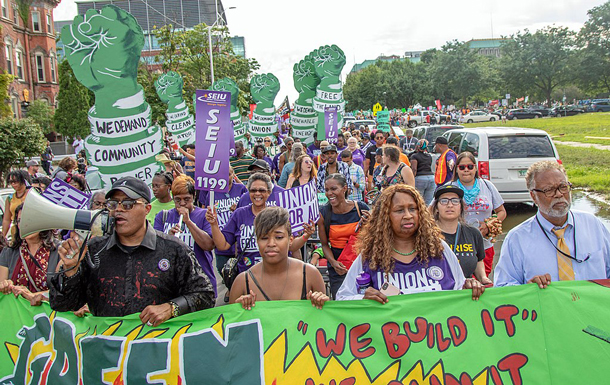
Activists marched to ask politicians to “Make Detroit the Engine of the Green New Deal!” on July 31, 2019. (Photo:Becker 1999, Wikimedia Commons CC BY 2.0)
KLEIN: Well, this is why I don't believe we can talk about climate change as just, you know, about being differing sets of policies. I think we are living the result of a worldview that has always been based on dominating people and nature. And that worldview has produced the climate crisis, and that we actually need not just new policies, but as Greta says, we need new ways of thinking that are not based on competition, dominance, hierarchy. And we can't be afraid to talk about the language of morality when it comes to climate change, the language of values.
CURWOOD: Naomi Klein, before you go, would you mind reading a passage from your book for us?
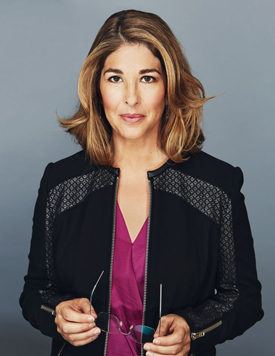
Naomi Klein (Photo: Kourosh Keshiri)
KLEIN: Oh, I'd love to, thank you. This is from the end of the, of the introduction. ‘
The message coming from the school strikes is that a great many young people are ready for this kind of deep change. They know all too well that the sixth mass extinction is not the only crisis they have inherited. They are also growing up in the rubble of market euphoria, in which the dreams of endlessly rising living standards have given way to rampant austerity and economic insecurity. And techno-utopianism, which imagined a frictionless future of limitless connection and community, has morphed into addiction to the algorithms of envy, relentless corporate surveillance, and spiraling online misogyny and white supremacy.
"When you have done your homework," Greta Thunberg says, "you realize that we need new politics. We need a new economics, where everything is based on our rapidly declining and extremely limited carbon budget. But that is not enough. We need a whole new way of thinking . . . We must stop competing with each other. We need to start cooperating and sharing the remaining resources of this planet in a fair way." (Unquote.)
Because our house is on fire, and this should come as no surprise. Built on false promises, discounted futures, and sacrificial people, it was rigged to blow from the start. It's too late to save all of our stuff, but we can still save each other and a great many other species, too. Let's put out the flames and build something different in its place. Something a little less ornate, but with room for all those who need shelter and care.
CURWOOD: Naomi Klein is a journalist, activist, and her new book is called On Fire: The (Burning) Case for a Green New Deal. Naomi, thanks so much for taking the time.
KLEIN: Thank you so much, it was a pleasure and a privilege.
Related links:
- On Fire: The (Burning) Case for a Green New Deal by Naomi Klein
- Watch: “A Message From the Future with Alexandria Ocasio-Cortez”
[MUSIC: Eugene Friesen/Paul Winter, “Bach Goes To Brazil” on SolsticeConcert.com]
CURWOOD: Living on Earth is produced by the World Media Foundation. Our crew includes Naomi Arenberg, Bobby Bascomb, Paloma Beltran, Thurston Briscoe, Jenni Doering, Jay Feinstein, Merlin Haxhiymeri, Don Lyman, Lizz Malloy, Aynsley O’Neill, Jake Rego, and Jolanda Omari. Tom Tiger engineered our show. Alison Lirish Dean composed our themes. You can hear us anytime at L-O-E dot org, iTunes and Google play- and like us, please, on our Facebook page - PRI’s Living on Earth. We tweet from @livingonearth. And find us on Instagram at livingonearthradio. I’m Steve Curwood. Thanks for listening!
ANNOUNCER: Funding for Living on Earth comes from you, our listeners, and from the University of Massachusetts, Boston, in association with its School for the Environment, developing the next generation of environmental leaders. And from the Grantham Foundation for the protection of the environment, supporting strategic communications and collaboration in solving the world’s most pressing environmental problems. Support also comes from the Energy Foundation, serving the public interest by helping to build a strong, clean, energy economy.
ANNOUNCER 2: PRI, Public Radio International.
Living on Earth wants to hear from you!
Living on Earth
62 Calef Highway, Suite 212
Lee, NH 03861
Telephone: 617-287-4121
E-mail: comments@loe.org
Newsletter [Click here]
Donate to Living on Earth!
Living on Earth is an independent media program and relies entirely on contributions from listeners and institutions supporting public service. Please donate now to preserve an independent environmental voice.
NewsletterLiving on Earth offers a weekly delivery of the show's rundown to your mailbox. Sign up for our newsletter today!
 Sailors For The Sea: Be the change you want to sea.
Sailors For The Sea: Be the change you want to sea.
 The Grantham Foundation for the Protection of the Environment: Committed to protecting and improving the health of the global environment.
The Grantham Foundation for the Protection of the Environment: Committed to protecting and improving the health of the global environment.
 Contribute to Living on Earth and receive, as our gift to you, an archival print of one of Mark Seth Lender's extraordinary wildlife photographs. Follow the link to see Mark's current collection of photographs.
Contribute to Living on Earth and receive, as our gift to you, an archival print of one of Mark Seth Lender's extraordinary wildlife photographs. Follow the link to see Mark's current collection of photographs.
 Buy a signed copy of Mark Seth Lender's book Smeagull the Seagull & support Living on Earth
Buy a signed copy of Mark Seth Lender's book Smeagull the Seagull & support Living on Earth

